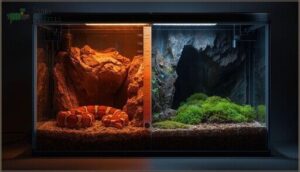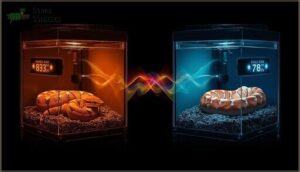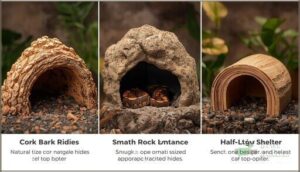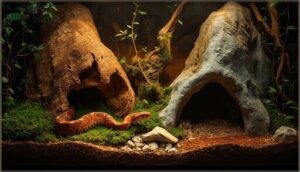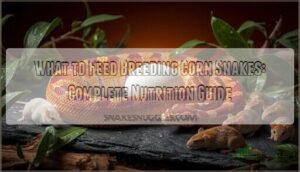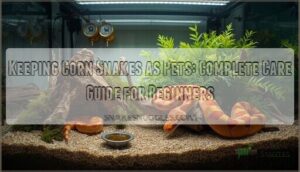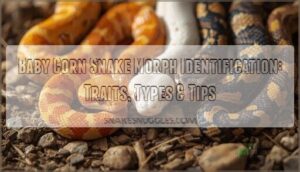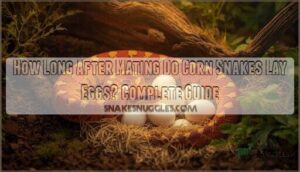This site is supported by our readers. We may earn a commission, at no cost to you, if you purchase through links.
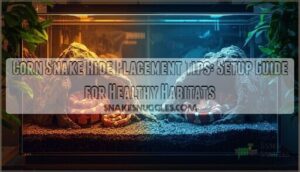
A corn snake pressed against the glass wall of its enclosure isn’t admiring the view—it’s searching for cover it can’t find. Without properly positioned hides, your snake experiences chronic stress that weakens its immune system and disrupts feeding patterns.
The solution isn’t just adding more hides to the tank. Strategic placement transforms a bare enclosure into a functional habitat where your snake can thermoregulate, digest meals in privacy, and exhibit natural behaviors. Position hides incorrectly, and you’ll watch your snake choose visibility over comfort, a clear signal something’s wrong.
Mastering corn snake hide placement tips means understanding how temperature zones, entrance size, and visual barriers work together to create security.
Table Of Contents
Key Takeaways
- Position at least two hides per snake—one on the warm side (80-85°F) and one on the cool side (75-82°F)—so your snake can thermoregulate without sacrificing security.
- Choose snug, opaque hides that fit your snake’s coiled body size closely, as oversized or transparent options eliminate the darkness and tight-space contact that reduce stress.
- Place hides away from high-traffic areas and use digital probes inside each hide to monitor actual microclimate temperatures, not just ambient readings.
- Maintain humidity levels of 65-75% and replace non-porous hides every 3-6 months while changing porous materials every 2-3 months to prevent pathogen buildup.
Importance of Proper Hide Placement
Your corn snake needs more than just food and water to thrive—it needs places to feel safe. Proper hide placement directly affects stress levels, natural behaviors, and overall health.
Let’s look at why getting this right makes all the difference in your snake’s well-being.
Stress Reduction and Security
Snake anxiety drops dramatically when you provide proper hiding spots with strong security features. Dark, snugly-fitting hide boxes reduce stress by making your corn snake feel escape-proof from perceived threats. Without adequate environmental enrichment through well-designed hides, your snake remains visibly exposed and anxious.
Stress mitigation starts with strategic hide design—darkness and tight spaces trigger instinctual security responses that calm your pet. Providing the right temperature regulation is also essential for reducing stress and creating a healthy habitat.
Encouraging Natural Behaviors
Your corn snake needs environmental enrichment to reveal its full behavioral diversity. Proper hiding spots don’t just reduce stress—they activate natural behaviors your snake evolved to perform.
- Climbing and exploration: Branches and elevated hides encourage arboreal activity patterns
- Burrowing instincts: Substrate depth allows digging behaviors typical of naturalistic settings
- Thermoregulation choices: Multiple hides let your snake select ideal temperature zones independently
- Activity cycling: Secure retreats support crepuscular patterns—dawn and dusk exploration
Habitat complexity directly increases your snake’s visible activity and engagement with its snake enclosure. To create a suitable environment, consider the importance of good ventilation systems for your corn snake’s health and well-being.
Impact on Health and Well-being
When your snake can’t retreat to secure hiding spots, its stress levels climb—and that compromises immune systems you can’t see weakening. Proper hide security prevents this cascade.
Snakes with adequate shelter maintain stronger digestive health, show consistent feeding responses, and resist respiratory infections more effectively.
Environmental enrichment through strategic hide placement isn’t decoration—it’s preventive reptile care that protects your corn snake’s long-term wellness through stress management.
Positioning Hides for Optimal Thermoregulation
Your corn snake can’t regulate its body temperature on its own—it relies on you to set up the right environment. Strategic hide placement gives your snake access to different temperature zones without forcing it to choose between feeling safe and feeling comfortable.
Let’s look at how to position hides so your snake can thermoregulate naturally while staying secure.
Placing Hides on Warm and Cool Sides
Your enclosure layout should include hiding spots on both the warm and cool sides to support proper thermoregulation. Position one hide near the basking spot where temperatures reach 80-85°F, and another on the cool side at 75-82°F.
This thermal gradient lets your corn snake choose its preferred temperature zone, directly influencing snake behavior, humidity levels management, and overall temperature control for ideal corn snake care.
Using a Long Hide for Temperature Gradient
A single elongated hide stretching across your enclosure’s thermal zones lets your corn snake thermoregulate without leaving cover—a breakthrough for stress reduction. Long hide placement gives your snake access to both warm (85°F) and cool (75-78°F) ends within one secure refuge:
- Cork bark or hollow logs work best for temperature gradient management
- Position it spanning your heat source to the cooler substrate area
- Keep the internal diameter about 1-2 inches wider than your snake’s body
- Dark, textured materials improve security while supporting enclosure climate control
This setup mimics natural refuges perfectly.
Monitoring Temperature Zones Inside Hides
Without accurate temperature probes inside your hiding spots, you’re flying blind on thermal regulation. Digital probes positioned in each hide reveal the actual microclimate control your snake experiences—not just glass surface readings.
Map heat gradients by checking both ends: warm-side hides should read 81-85°F, cool-side refuges 75-82°F. Regular hide calibration prevents overheating and aids proper thermal mapping across temperature zones.
Selecting The Best Hide Types and Sizes
Choosing the right hide isn’t just about aesthetics—it directly affects your corn snake’s stress levels and willingness to use the shelter you provide. The size needs to match your snake’s body dimensions, and the material should create that cave-like darkness they instinctively seek.
Let’s break down what works best and why certain options fall short.
Ideal Hide Dimensions for Corn Snakes
Getting hide box dimensions right makes all the difference—your corn snake habitat needs hiding spots sized for security, not sprawl. Adult corn snakes thrive with hides around 23 cm by 18 cm, while hatchlings start smaller.
Here’s what matters for enclosure layout:
- Match the snake’s coiled size: Snug fit encourages natural snake behavior and temperature control
- Avoid oversized options: Too much space inside reduces security
- Adjust as they grow: Upgrade hide size guidelines with your snake’s development
Materials That Enhance Security
Choosing the right materials transforms hiding spots from basic shelter into secure retreats. Your snake enclosure benefits most from materials designed for durability and safety.
| Material Type | Security Benefits | Maintenance Notes |
|---|---|---|
| Resin Hides | Non-toxic, mold-resistant, stable temps | Easy cleaning, long-lasting |
| Natural Woods | Mimics wild refuges, dark interiors | Pre-treat to kill parasites |
| Foam Coatings | Lightweight, customizable shapes | Verify full curing before use |
| Plastic Containers | Non-porous, bacteria-resistant | Quick sanitizing, escapeproof design |
Synthetic materials and treated bark offer consistent thermal properties while resisting breakdown in humid conditions.
Avoiding Oversized or Transparent Hides
Hide size optimization directly impacts your corn snake’s stress levels and hiding behavior. When selecting hiding spots for your snake enclosure, avoid these three critical errors:
- Oversized cavities – Your corn snake needs snug contact with walls; large spaces undermine security features
- Transparent materials – Clear hides eliminate darkness required for concealment
- Mismatched enclosure layout – Hide proportions should match your snake’s current body diameter for ideal security
Enhancing Hide Effectiveness Within The Enclosure
You’ve chosen the right hide and positioned it carefully, but your work isn’t finished yet. A few strategic adjustments can transform a good hide into one your corn snake actually uses.
Let’s explore three practical ways to boost hide effectiveness and create a truly secure environment.
Creating Darkness and Privacy
Your corn snake’s hides must block out light completely—darkness isn’t optional; it’s essential for snake security. Transparent or semi-open hiding spots won’t cut it. Choose opaque materials like solid plastic, bark, or half logs that create true private spaces with enclosure shadows. For albino morphs especially, light reduction becomes critical.
Here’s how darkness affects your snake’s well-being:
| Hide Feature | Impact on Corn Snake Care |
|---|---|
| Complete darkness | Reduces stress, aids thermoregulation |
| Narrow entrance | Enhances privacy perception |
| Opaque materials | Blocks external light effectively |
| Multiple dark hides | Provides choices across temperature zones |
| Non-reflective interiors | Maximizes light reduction |
Monitor your snake’s behavior—if it’s avoiding hides during the day, insufficient darkness may be the culprit, affecting both feeding patterns and humidity levels inside your snake enclosure.
Integrating Hides With Enclosure Decor
Once you’ve nailed darkness and privacy, blend your decorative hide options with naturalistic environments to create microclimate creation zones. Position cork bark near climbing branches so your snake explores multiple levels. Tuck hides beneath trailing pothos or alongside driftwood—these visual barriers reduce exposure stress while maintaining proper substrate options depth.
Strategic habitat enrichment transforms your corn snake habitat:
- Cork bark shaped into caves doubles as shelter and climbing ramps for exploration
- Half logs concealed with artificial plants improve security perception across enclosure size
- Driftwood positioned near hiding spots encourages natural shedding behaviors
- Rocks anchoring hides prevent displacement while creating temperature corridors
- Sphagnum moss tucked under warm-side hides maintains localized humidity for physiological support
Ensuring Easy Access and Cleaning
Beyond aesthetics, your corn snake habitat needs functional Accessible Hide Design. Position hiding spots near the enclosure’s front for Easy Reach Hides during routine checks—this cuts handling time by 30-40% compared to corner placements.
Choose removable tops for quick Cleaning Schedules while maintaining humidity control across substrate options.
| Hide Material Selection | Sanitation Protocols |
|---|---|
| Smooth plastic resists odors | Weekly spot cleaning |
| Ceramic wipes clean easily | Monthly deep disinfection |
| Avoid porous wood | Replace every 12-18 months |
Common Hide Placement Mistakes to Avoid
Even experienced keepers can make setup errors that compromise their corn snake’s comfort and health. Understanding what doesn’t work is just as important as knowing what does.
Let’s walk through the most common hide placement mistakes so you can create a truly effective habitat from the start.
Overcrowding or Insufficient Hides
Overcrowding or insufficient hiding spots create serious snake stress factors that you can’t afford to ignore. Stick to one adult corn snake per 40-gallon enclosure size with proper hide density—meaning at least two hides per snake.
Cramming multiple snakes into tight quarters without adequate hiding spots triggers welfare impacts like respiratory infections, aggressive displays, and feeding refusals. Your corn snake habitat needs breathing room and security to support stress reduction.
Placing Hides in High-Traffic or Exposed Areas
Traffic hide stress isn’t just theory—snakes in exposed locations show 43% more stress behaviors and refuse food 2.4 times more often. Your corn snake habitat needs visual barrier needs met, so position hiding spots away from foot traffic and direct sightlines.
Position corn snake hides away from foot traffic—exposed locations triple stress behaviors and double feeding refusals
Exposed hide risks include respiratory infections (29% increase) and defensive striking that quadruples in juveniles. Snake anxiety levels drop dramatically when you prioritize privacy over convenience in your enclosure size planning.
Ignoring Temperature and Humidity Needs
Most hide failures stem from ignoring microclimate needs inside each refuge. Your corn snake care depends on hide microclimates maintaining 80-85°F in warm zones and proper humidity levels of 65-75%.
Temperature gradients between hides enable thermoregulation, while humidity control prevents shedding complications. Environmental fluctuations without thermostatic monitoring cause thermal stress that compromises immune function.
Reptile habitat design requires digital probes inside hides, not just ambient readings.
Frequently Asked Questions (FAQs)
How often should I replace corn snake hides?
Think of hide replacement like rotating bedsheets—non-porous plastic hides need thorough disinfection weekly and replacement every three to six months, while porous wooden or organic materials require changing every two to three months to prevent pathogen accumulation.
Can corn snakes share hides with other snakes?
No—corn snakes are solitary by nature and don’t share hides. Cohabitation risks injury, stress, and feeding-related aggression, even among siblings. Always provide individual hides for each snake to guarantee safety and proper thermoregulation.
Whats the best hide arrangement for breeding pairs?
Breeding pairs need at least four hides—two per snake—positioned on warm and cool sides for temperature gradient management.
This setup reduces competitive behavior, encourages stress reduction, and aids effective reptile habitat design throughout breeding cycles.
Should hatchlings have different hide materials than adults?
You’ll want disposable paper or cardboard hides for hatchlings—they’re easier to sanitize daily.
Adults do better with durable plastic or sealed wood options that withstand weekly cleaning and maintain stable humidity control.
Conclusion
Does your snake still glass-surf after repositioning its hides? The missing piece is often humidity. Corn snake hide placement tips work best when paired with moisture gradients—place a humid hide near your warm zone during shed cycles.
Your snake’s behavior reveals what words can’t: a properly hidden snake is a thriving snake. Watch for extended time inside hides and confident nighttime exploration. These signals confirm you’ve built security into every temperature zone your snake needs.
- https://www.reptilecentre.com/pages/info-corn-snake-care-sheet
- https://www.zenhabitats.com/blogs/reptile-care-sheets-resources/corn-snake-general-reptile-care-guide-reptifiles?srsltid=AfmBOooNl7Xdw8UG8AtKC1EhwzfxDQJq4CoDDqCfDjsycTluIMNjl_8a
- https://community.morphmarket.com/t/corn-snake-care-guide/39834
- https://cornsnake.net/pages/hides
- https://docs.google.com/document/d/1SEVH4NNSdWQsOUZ44HnbnXlDZ9AVGyE6Kf4GvfNHrSQ/mobilebasic

